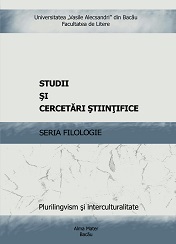SEMIOTICA GESTURILOR ÎN OPERA HORTENSIEI PAPADAT-BENGESCU
Semiotics of gestures in the literary work of Hortensia Papadat-Bengescu
Author(s): Claudia Andreea Hărmănescu (Lefter)Subject(s): Language and Literature Studies, Studies of Literature, Romanian Literature, Philology
Published by: Editura Alma Mater
Keywords: body; limits; creativity; spirit; instinct;
Summary/Abstract: In literature, sensuality and sexuality are some kind of big words, not used quite usually. In Hortensia Papadat-Bengescu’s books there is an infusion of body language words. The body language, seen as topos, acquires multiple senses in the short stories. Sensuality appears obsessive. One of the meanings it presents is the configuration of Don Juan as the receiver of the letters. To him, Bianca Porporata reveals his soul, trying to deny reality by epistles sent to eternity. Love for Don Juan is ideal, the man appears as the double of Bianca, as her need to confess, as the projection of male pre-existing perfection in a woman. The Heroine is the spokesman for femininity: “Who knows better than you what you women are?” The woman choses the exciting virtual, instead of lonely life, overcoming loneliness. Don Juan is, as his legend says, another aspect of loneliness. Masculinity appears in the Bengali novella as a quiet confessor who does not disturb the confession, is just a satisfactory sexual project. The spirit as a myth also appears in the song Who Loved Alisia, when the uncle of the girl evokes his appearance
Journal: Studii și cercetări științifice. Seria filologie
- Issue Year: 2019
- Issue No: 41
- Page Range: 167-176
- Page Count: 9
- Language: Romanian

